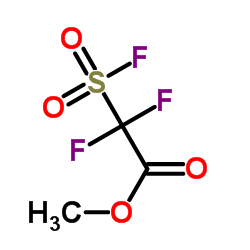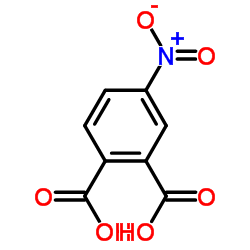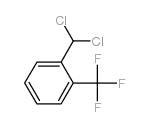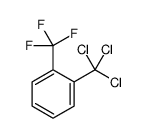4-Nitro-1,2-bis(trifluoromethyl)benzene
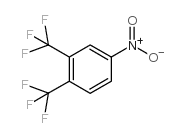
4-Nitro-1,2-bis(trifluoromethyl)benzene structure
|
Common Name | 4-Nitro-1,2-bis(trifluoromethyl)benzene | ||
|---|---|---|---|---|
| CAS Number | 1978-20-7 | Molecular Weight | 259.10500 | |
| Density | 1.539g/cm3 | Boiling Point | 208.6ºC at 760mmHg | |
| Molecular Formula | C8H3F6NO2 | Melting Point | 23-25 °C | |
| MSDS | N/A | Flash Point | 80ºC | |
| Name | 4-Nitro-1,2-bis(trifluoromethyl)benzene |
|---|---|
| Synonym | More Synonyms |
| Density | 1.539g/cm3 |
|---|---|
| Boiling Point | 208.6ºC at 760mmHg |
| Melting Point | 23-25 °C |
| Molecular Formula | C8H3F6NO2 |
| Molecular Weight | 259.10500 |
| Flash Point | 80ºC |
| Exact Mass | 259.00700 |
| PSA | 45.82000 |
| LogP | 4.15560 |
| Vapour Pressure | 0.305mmHg at 25°C |
| Index of Refraction | 1.421 |
Synonym:3,4-Bis(trifluoromethyl)nitrobenzen Section 2 - COMPOSITION, INFORMATION ON INGREDIENTS
Risk Phrases: 36/37/38 Section 3 - HAZARDS IDENTIFICATION EMERGENCY OVERVIEW
Irritating to eyes, respiratory system and skin. Potential Health Effects Eye: Causes eye irritation. Skin: Causes skin irritation. May be harmful if absorbed through the skin. Ingestion: May cause irritation of the digestive tract. May be harmful if swallowed. Inhalation: Causes respiratory tract irritation. May be harmful if inhaled. Chronic: Not available. Section 4 - FIRST AID MEASURES Eyes: Flush eyes with plenty of water for at least 15 minutes, occasionally lifting the upper and lower eyelids. Get medical aid. Skin: Get medical aid. Flush skin with plenty of water for at least 15 minutes while removing contaminated clothing and shoes. Ingestion: Get medical aid. Wash mouth out with water. Inhalation: Remove from exposure and move to fresh air immediately. If not breathing, give artificial respiration. If breathing is difficult, give oxygen. Get medical aid. Notes to Physician: Treat symptomatically and supportively. Section 5 - FIRE FIGHTING MEASURES General Information: As in any fire, wear a self-contained breathing apparatus in pressure-demand, MSHA/NIOSH (approved or equivalent), and full protective gear. Extinguishing Media: Use water spray, dry chemical, carbon dioxide, or chemical foam. Section 6 - ACCIDENTAL RELEASE MEASURES General Information: Use proper personal protective equipment as indicated in Section 8. Spills/Leaks: Absorb spill with inert material (e.g. vermiculite, sand or earth), then place in suitable container. Section 7 - HANDLING and STORAGE Handling: Avoid breathing dust, vapor, mist, or gas. Avoid contact with skin and eyes. Storage: Store in a cool, dry place. Store in a tightly closed container. Section 8 - EXPOSURE CONTROLS, PERSONAL PROTECTION Engineering Controls: Facilities storing or utilizing this material should be equipped with an eyewash facility and a safety shower. Use adequate ventilation to keep airborne concentrations low. Exposure Limits CAS# 1978-20-7: Personal Protective Equipment Eyes: Not available. Skin: Wear appropriate protective gloves to prevent skin exposure. Clothing: Wear appropriate protective clothing to prevent skin exposure. Respirators: Follow the OSHA respirator regulations found in 29 CFR 1910.134 or European Standard EN 149. Use a NIOSH/MSHA or European Standard EN 149 approved respirator if exposure limits are exceeded or if irritation or other symptoms are experienced. Section 9 - PHYSICAL AND CHEMICAL PROPERTIES Physical State: Liquid Color: pale yellow Odor: Not available. pH: Not available. Vapor Pressure: Not available. Viscosity: Not available. Boiling Point: 103 - 104 deg C @18mmHg Freezing/Melting Point: Not available. Autoignition Temperature: Not available. Flash Point: Not available. Explosion Limits, lower: Not available. Explosion Limits, upper: Not available. Decomposition Temperature: Solubility in water: Specific Gravity/Density: Molecular Formula: C8H3F6NO2 Molecular Weight: 259 Section 10 - STABILITY AND REACTIVITY Chemical Stability: Not available. Conditions to Avoid: Incompatible materials. Incompatibilities with Other Materials: Oxidizing agents. Hazardous Decomposition Products: Nitrogen oxides, carbon monoxide, carbon dioxide, fluorine, hydrogen fluoride gas. Hazardous Polymerization: Has not been reported Section 11 - TOXICOLOGICAL INFORMATION RTECS#: CAS# 1978-20-7 unlisted. LD50/LC50: Not available. Carcinogenicity: 4-Nitro-1,2-di(trifluoromethyl)benzene - Not listed by ACGIH, IARC, or NTP. Section 12 - ECOLOGICAL INFORMATION Section 13 - DISPOSAL CONSIDERATIONS Dispose of in a manner consistent with federal, state, and local regulations. Section 14 - TRANSPORT INFORMATION IATA No information available. IMO No information available. RID/ADR No information available. Section 15 - REGULATORY INFORMATION European/International Regulations European Labeling in Accordance with EC Directives Hazard Symbols: XI Risk Phrases: R 36/37/38 Irritating to eyes, respiratory system and skin. Safety Phrases: S 26 In case of contact with eyes, rinse immediately with plenty of water and seek medical advice. S 37/39 Wear suitable gloves and eye/face protection. WGK (Water Danger/Protection) CAS# 1978-20-7: No information available. Canada None of the chemicals in this product are listed on the DSL/NDSL list. CAS# 1978-20-7 is not listed on Canada's Ingredient Disclosure List. US FEDERAL TSCA CAS# 1978-20-7 is not listed on the TSCA inventory. It is for research and development use only. SECTION 16 - ADDITIONAL INFORMATION N/A |
|
~% 
4-Nitro-1,2-bis... CAS#:1978-20-7 |
| Literature: US5514680 A1, ; US 5514680 A |
|
~% 
4-Nitro-1,2-bis... CAS#:1978-20-7 |
| Literature: J. Gen. Chem. USSR (Engl. Transl.), , vol. 39, # 9 p. 2053 - 2056,2007 - 2010 |
|
~% 
4-Nitro-1,2-bis... CAS#:1978-20-7 |
| Literature: Journal of the Chemical Society, , p. 4003 - 4010 |
|
~% 
4-Nitro-1,2-bis... CAS#:1978-20-7 |
| Literature: Journal of the Chemical Society, , p. 4003 - 4010 |
|
~% 
4-Nitro-1,2-bis... CAS#:1978-20-7 |
| Literature: Journal of the Chemical Society, , p. 4003 - 4010 |
|
~% 
4-Nitro-1,2-bis... CAS#:1978-20-7 |
| Literature: Journal of the Chemical Society, , p. 4003 - 4010 |
| HS Code | 2904909090 |
|---|---|
| Summary | HS:2904909090 sulphonated, nitrated or nitrosated derivatives of hydrocarbons, whether or not halogenated VAT:17.0% Tax rebate rate:9.0% Supervision conditions:none MFN tariff:5.5% General tariff:30.0% |
| 4-nitro-1,2-bis(trifluoromethyl)benzene |
| 3,4-Bis(trifluoromethyl)nitrobenzene |
